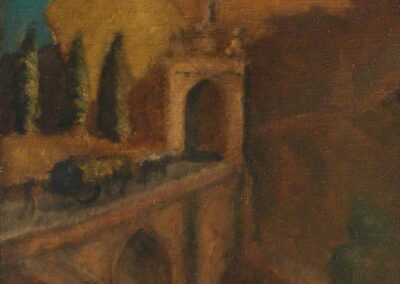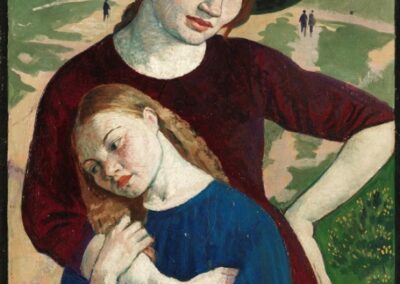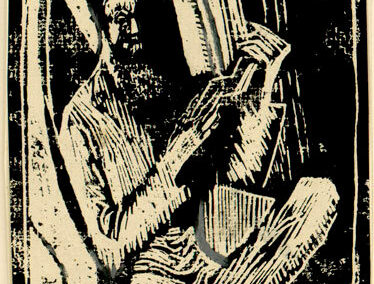Our next Artist You Need To Know is Dora Carrington (1893 – 1932).
She was an English painter, designer and decorative artist, remembered (perhaps too much so) for her association with members of the Bloomsbury Group.
Born Dora de Houghton Carrington, she was better known as simply Carrington, eschewing her first name as ‘trite’. Like many female artists, Carrington was not well known as a painter during her lifetime, as she rarely exhibited and did not sign her work, but her importance in the history of British art has been recognized in the decades since her passing. She worked for a while at the Omega Workshops, and for the Hogarth Press, designing woodcuts.
Sir John Rothenstein (who was the Director of the Tate in London for nearly three decades) described Dora Carrington as “the most neglected serious painter of her time.”
Carrington was born in Hereford into a comfortable middle-class family : as a student at the all-girls Bedford High School (which had a strong emphasis on art, and her parents encouraged her talent in this area, paying for her to have lessons outside the usual curriculum) , Carrington won a number of awards in the national school competitions that were facilitated by the Royal Drawing Society.
She left home at 17 to attend the Slade School of Art (1910–14) which was just at the forefront of gender equality in art education. Contemporaries of Carrington at Slade included Dorothy Brett, Paul Nash, C. R. W. Nevinson and Mark Gertler.
While still a student, in 1912, Carrington was impressed by a series of lectures by the artist and muralist Mary Sargant Florence on fresco painting : this would inspire her, in collaboration with Constance Lane to create three large frescoes for a library at Ashridge in the Chiltern Hills, Hertfordshire, north west of London.
In 1918, Carrington’s father died. Her inheritance from him granted her some financial security, and subsequent artistic independence. As she once lamented : “If only I had any money I should not be obliged to stick at home like this. And to earn money every day, and paint what one wants to, seems almost impossible.”
After graduating from the Slade, Carrington took up decorative commissions to make a living, one of which was producing woodcuts for Virginia and Leonard Woolf’s fledgling Hogarth Press. This led to her initial association with the Bloomsbury Group.
“Though she was friendly with many members of the group and maintained a regular correspondence with [Virginia] Woolf, Carrington was more of a fringe player in Bloomsbury. While working at the Omega Workshops in 1916, she met the writer Lytton Strachey, who would be her main love over the course of her life.
Even though he was openly homosexual, Carrington had deep romantic feelings for him. Their enduring friendship had much in common with a marriage, but, for her part, Carrington also explored other romantic relationships with both men and women.” (from here)
In 1917 she began to live with Strachey and their relationship was a continuing – if contested, as to whether it was positive or negative to her artwork – element of her artistic life.
Her association with the aforementioned Bloomsbury Group, a set of twentieth-century English writers, intellectuals, and artists, including Virginia Woolf, John Maynard Keynes, and E. M. Forster, has regrettably formed most interpretations of Carrington’s art and life, often being more about the salacious liaisons than about her significance as an artist.
“I would like this year (since for the first time I seem to be without any relations to complicate me) to do more painting. But this is a resolution I have made for the last ten years.”
Carrington’s “impressive body of work is often overshadowed by the fiery dramas of her personal and romantic life. Indeed it can be difficult to ignore her many unconventional romances, her ambiguous sexual identity, and the dramatic suicide that ended her life when she was only thirty-eight years old. But looking beyond her sensational biography and carefully examining her work – which took the form of both painting and decorative arts – reveals an artist with a singular perspective.” (from here)
Carrington was one of the artists whom the British Arts Council and Chanel 4 highlighted in their television series Five Women Painters (1989). The Barbican Art Gallery in London also mounted a major retrospective of her artwork in 1995. Her work can be found in the collection of the Tate.
One of the ways in which Carrington has been introduced to a new audience, decades after her passing, was through the movie Carrington (1985), which was a biography of the artist (portrayed by Emma Thompson) which was written and directed by Christopher Hampton. The film and script was based upon the book Lytton Strachey by Michael Holroyd. Holroyd also wrote the foreword to the book The Art of Dora Carrington, by Jane Hill, which was published by Thames and Hudson in 1994. In that text he offered that “Carrington was principally an autobiographical artist who painted the people and places she loved…Her life bears witness to ‘a great deal of a great many kinds of love’, and a knowledge of the intensifying complications this led to enables us to look at her pictures with special intimacy and understanding…”
Dora Carrington died by her own hand on the 11th of March, in 1932, at the age of 38, two months after Lytton Strachey’s death, by a self inflicted gunshot wound. Their tumultuous relationship had defined – or perhaps deformed – her life, and in her letters (which have been published and are as evocative as her paintings) her devotion and exasperation with him are eloquently expressed.
She was cremated : some accounts claim that the ashes were buried under the laurels in the garden of Ham Spray House. Alternately, Jane Hill, in her aforementioned book about Carrington states that “no one who was there can remember what became of her ashes; and so she lived and died covering her tracks, but failing to obliterate her own tragedy. Although she had the makings of a great painter, Carrington was too gently made and seemingly had no desire for posterity through progeny or paint.”
From Art UK : “Carrington never exhibited during her lifetime and her career was perhaps blighted by the specifically feminine contradictions that faced early twentieth-century women artists. She was expected to occupy a female, domestic role, supporting the men around her yet never taken seriously as an artist, in part due to her ‘feminine’ decorative work and because the salacious details of her love life detracted from an interest in her artistic abilities and achievements.”
More about her life and work can be seen here, here and here.



























